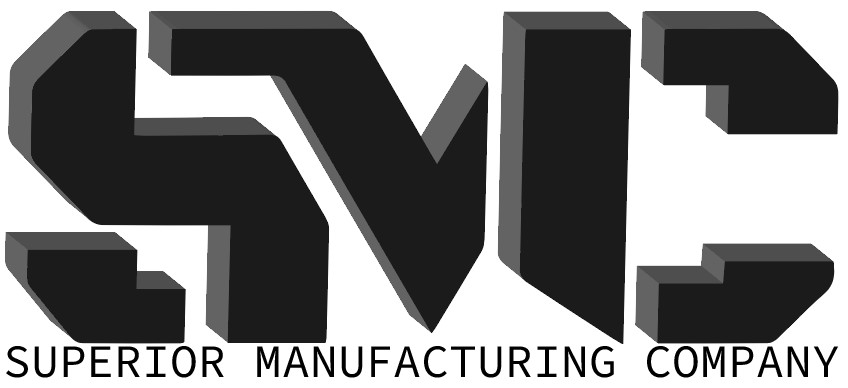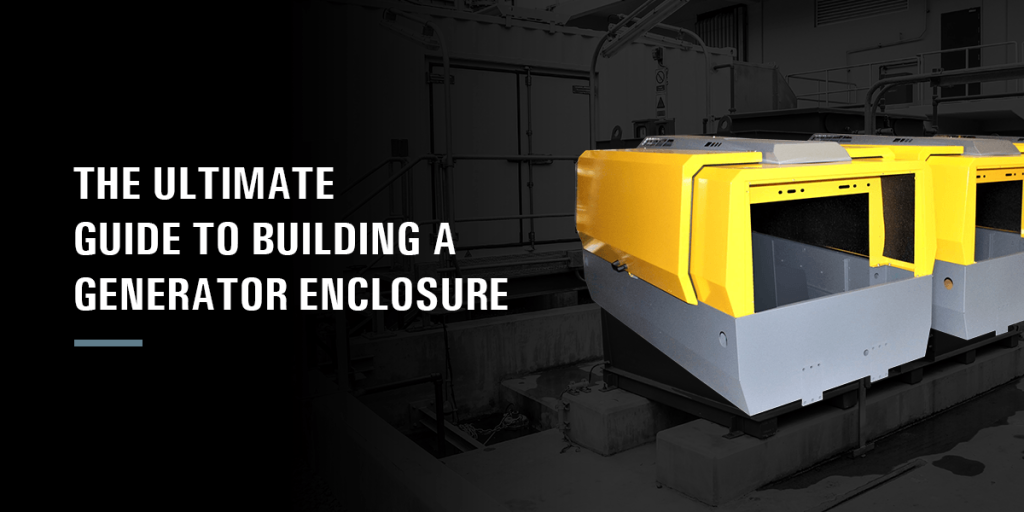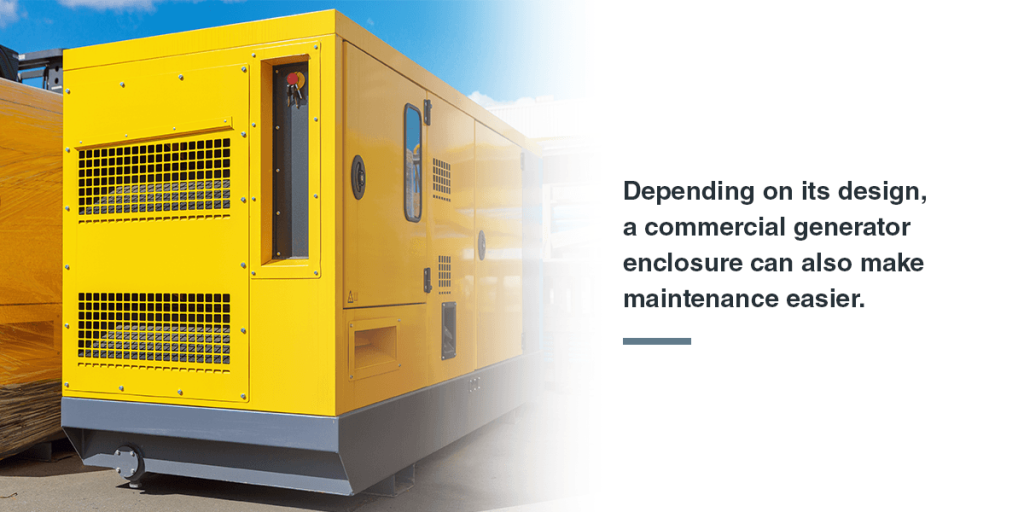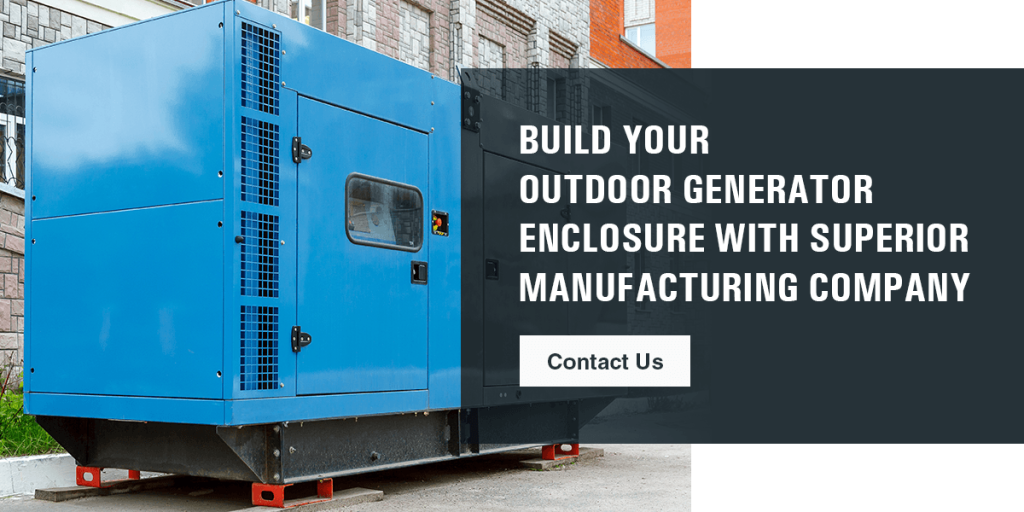What Is a Generator Enclosure?
Reasons to Build a Generator Enclosure
Types of Generator Enclosures
Safety Considerations When Building a Generator Enclosure
Build Your Outdoor Generator Enclosure With Superior Manufacturing Company
Commercial generator enclosures are a necessary part of using these power solutions. They protect the generator from the elements, vandalism and more while providing safety benefits for everyone in the area. Generator enclosure designs can vary widely, and building the right one for a generator is key to getting the most out of it. We’ve put together a guide on how to build a generator enclosure that meets the machine’s needs, supports optimal operating conditions and keeps employees safe.
What Is a Generator Enclosure?
Generator enclosures are large protective barriers surrounding a permanent or portable generator. In commercial settings, outdoor generator enclosures are typically made of heavy-duty materials and designed specifically for the generator’s needs, with appropriate ventilation and access points. They support optimal operation, such as cool temperatures and maintenance demands, while offering protection from the weather, theft and vandalism.
Durable portable generator enclosures support:
- Ventilation: Although diesel generally produces less carbon monoxide (CO) than gasoline, both are capable of releasing dangerous levels of the substance. High CO can cause numerous issues, such as irritation to the eyes, throat, nose and respiratory tract, asthma, lightheadedness and cancer. Proper ventilation helps keep employees safe when entering a walk-in generator enclosure. It also ensures appropriate airflow for cooling requirements.
- Temperature: Since generators work best within their specified operating temperature ranges, enclosures must keep temperatures low with elements like radiators, fans, monitoring systems and ventilation.
- Security: Outdoor generator enclosures protect the equipment from theft and vandalism by providing a sturdy, lockable structure. It also keeps the generator safe from wildlife and pests, which could otherwise gnaw through wires or create fire hazards by making nests.
- Maintenance: A generator enclosure should offer enough space for technicians to access the machinery for maintenance and repairs.
- Fuel storage: Portable generator enclosures can also provide space for fuel so it’s protected and conveniently located nearby when it’s time to fill.
- Professional appearances: Lastly, a durable portable generator enclosure can maintain a professional appearance for years. A well-made portable enclosure won’t deteriorate or corrode and can be customized to complement different settings. Some users might want it to blend into the environment, match the facility or display branding materials.
Reasons to Build a Generator Enclosure
Along with protecting the equipment, outdoor generator enclosures affect the work environment, system reliability and upkeep. Here’s how:
- A safer, quieter work environment: By reducing noise levels and mitigating CO buildup, rugged enclosures can help eliminate some of the safety hazards associated with generators and minimize the need for additional precautions, such as earmuffs for nearby workers.
- Protection for your investments: Generators are a sizable expense, and enclosures can maximize the value of the buyer’s investment. They can prevent damage from weather, animals or vandalism, and they can support the generator’s longevity through better operating conditions.
- A more dependable generator system: Protecting a generator with a heavy-duty enclosure helps ensure it’s in good condition when users need it most. With outages on the rise, reliable generator systems are essential for continued operations, especially in critical businesses like healthcare and energy.
- Simplified maintenance and access: Depending on its design, a commercial generator enclosure can also make maintenance easier. Straightforward access means workers can streamline upkeep and get to the generator quickly during a power outage when time is precious.
Types of Generator Enclosures
There are several different styles of industrial generator enclosures to meet varying budgets and environmental demands. Explore the following to see what works best for various types of operations.
Weather-Protective Generator Enclosures
Protection from the elements is a must-have for outdoor generators, so weatherproof enclosures are the most basic option. They’ll keep machinery safe from rain, snow, wind and sunlight, as well as threats like particulate matter, which is common in some industrial environments. A weather-protective enclosure might also help with temperature changes and extreme cold or heat.
These enclosures are typically made of a solid metal, like steel or aluminum, that’s been weatherproofed.
Noise-Reducing Generator Enclosures
The Occupational Safety and Health Administration (OSHA) warns against hearing damage caused by loud sounds. If noise exposure exceeds 85 decibels (dB) when averaged for an 8-hour workday, employers must implement hearing conservation programs. While some generators are louder than others, noise-reducing enclosures can bring down the overall noise level at a work site or facility and are almost always necessary.
Typically, commercial facilities also have to limit noise levels according to zoning laws and noise-ordinance policies. A business in a residential area may have more need for a noise-reducing enclosure than one in an industrial location.
These sound-attenuating enclosures are typically larger and slightly more expensive than weatherproofed models, thanks to the insulation packed onto the walls. They significantly reduce a generator’s noise but won’t completely silence it. Mufflers can also help minimize sound.
Walk-In Generator Enclosures
Walk-in enclosures are the most comprehensive option, offering weather protection, noise reduction and fireproofing. As the name implies, these enclosures also allow workers to enter the space for easy maintenance and operation. This design is typically custom-created to fit the specific generator in use.
Safety Considerations When Building a Generator Enclosure
Commercial generator enclosures can help create a safer environment, but there are a few things to keep in mind when building one. Users should:
- Make sure all electrical connections and cables facing the outdoors are appropriately insulated and protected from the elements.
- Check all local laws about placement and noise restrictions before installing, as well as fire and electrical codes.
- Leave plenty of clear space on all sides of the enclosure for ventilation and cooling.
- Always disconnect all electrical components before installing or servicing the generator.
- Install an automatic transfer switch (ATS) to safely manage power supplies and quickly switch away from the public network when needed.
- Place the generator on high, level ground to prevent flooding and keep water from pooling around the machine.
Build Your Outdoor Generator Enclosure With Superior Manufacturing Company
When a company’s contingency plan is at stake, high-quality supplies are essential. Superior Manufacturing is an industry leader in metal fabrication, with a specialty in designing and engineering generator enclosures. We have over 75 years of experience in the industry, and our customers reap the benefits of everything we’ve learned. We use high-quality materials, expert craftsmanship, cost-effective methods and sophisticated machinery to bring your vision to life. Throughout the process, we’ll work closely with your team to identify ideal custom solutions for your generator and business.
To learn more about building outdoor generator enclosures, reach out to one of our knowledgeable team members today.




